翻译理论知识回顾
浙江省考研外国语言文学翻译理论知识点梳理
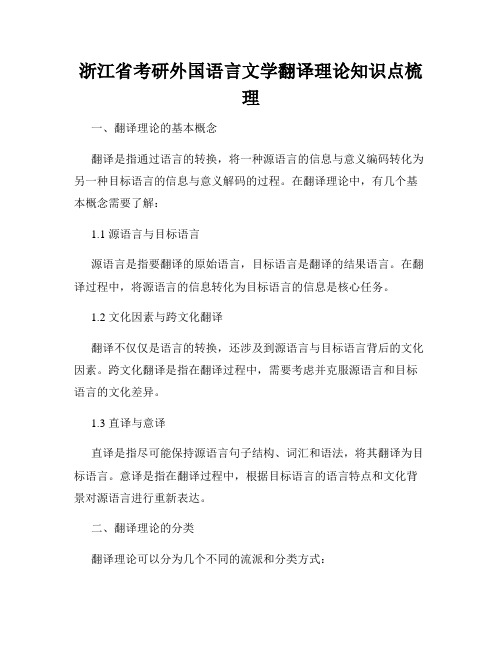
浙江省考研外国语言文学翻译理论知识点梳理一、翻译理论的基本概念翻译是指通过语言的转换,将一种源语言的信息与意义编码转化为另一种目标语言的信息与意义解码的过程。
在翻译理论中,有几个基本概念需要了解:1.1 源语言与目标语言源语言是指要翻译的原始语言,目标语言是翻译的结果语言。
在翻译过程中,将源语言的信息转化为目标语言的信息是核心任务。
1.2 文化因素与跨文化翻译翻译不仅仅是语言的转换,还涉及到源语言与目标语言背后的文化因素。
跨文化翻译是指在翻译过程中,需要考虑并克服源语言和目标语言的文化差异。
1.3 直译与意译直译是指尽可能保持源语言句子结构、词汇和语法,将其翻译为目标语言。
意译是指在翻译过程中,根据目标语言的语言特点和文化背景对源语言进行重新表达。
二、翻译理论的分类翻译理论可以分为几个不同的流派和分类方式:2.1 传统翻译理论传统翻译理论主要关注语言层面的转换,包括词汇、语法、句子结构等方面的处理。
代表性的理论有相当无理论、工科翻译理论等。
2.2 文化翻译理论文化翻译理论强调翻译过程中的文化因素,包括文化意象、价值观念、习惯用语等。
代表性的理论有劳德鲁普的文化翻译理论等。
2.3 功能翻译理论功能翻译理论关注翻译的目的和功能,包括传递信息、表达情感、文化交流等方面。
代表性的理论有新修订功能翻译理论等。
三、翻译理论的方法与技巧在翻译过程中,有一些常用的方法与技巧可以帮助提高翻译质量:3.1 目标语言优先原则目标语言优先原则是指在翻译过程中,优先考虑目标语言的表达习惯和规则,尽可能使翻译结果符合目标语言的语言习惯和文化背景。
3.2 多元化文本处理多元化文本处理是指在翻译过程中灵活运用不同的翻译策略和修辞手法,以达到更准确、流畅的翻译效果。
3.3 注意上下文语境上下文语境是翻译过程中必须关注的重要因素。
翻译时应仔细分析原文的上下文语境,确保翻译的准确性和连贯性。
四、翻译理论在实践中的应用翻译理论不仅仅是学术研究的范畴,也在实际翻译工作中起到指导和帮助作用:4.1 文学翻译文学翻译要求翻译者在保持原著意境的同时,注重目标语言的文化表达和美学效果。
翻译理论复习总结

翻译理论复习总结一、翻译的定义:1. 罗曼?雅克布逊Roman Jacobson: translation is an interpretation of verbal signs by means of some other language;2. 奈达(美国)Nida: translating consist in reproducing in the receptor language the closest equivalent of the source-language message, first in terms of meaning and secondly in terms of style.2、翻译的类型1、译原文作者为中心的翻译:author-centered translation;以译文读者为中心的翻译:reader-centered translation;2、提出者:罗曼·雅克布逊roman Jacobson:语内翻译intralingual translation、语际翻译interlingual translation、符际翻译intersemiotic translation3、翻译元素:翻译过程:translating译作A translation译者translator4、西方的一些观点:1、泰勒tytler: the translation should give a complete transcript of the idea of the original work; the style and manner should be of the same character with that of the original; the translation should have all the ease of original composition.2.be faithful to its spirit ,sense, and style;3.语义翻译semantic translation:纽马克newmark(英国)成名作《翻译研究途径》(Approaches to Translation,1981)中所提出的“语义翻译”与“交际翻译”之说在翻译教学与翻译研究界几乎人人皆知,至今仍有其理论价值与实践价值。
翻译讲座知识点归纳总结
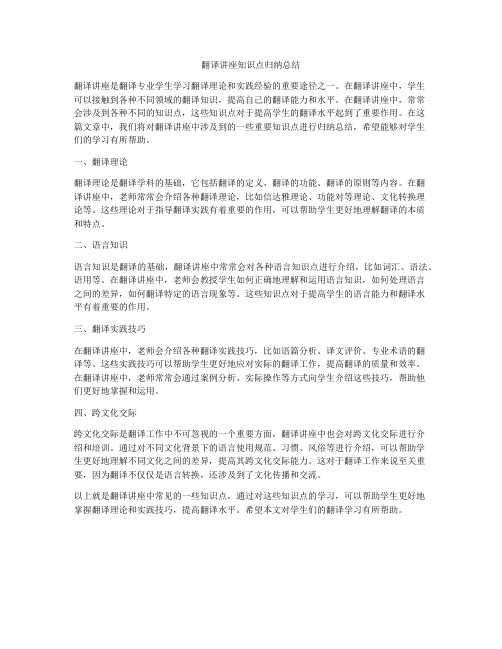
翻译讲座知识点归纳总结翻译讲座是翻译专业学生学习翻译理论和实践经验的重要途径之一。
在翻译讲座中,学生可以接触到各种不同领域的翻译知识,提高自己的翻译能力和水平。
在翻译讲座中,常常会涉及到各种不同的知识点,这些知识点对于提高学生的翻译水平起到了重要作用。
在这篇文章中,我们将对翻译讲座中涉及到的一些重要知识点进行归纳总结,希望能够对学生们的学习有所帮助。
一、翻译理论翻译理论是翻译学科的基础,它包括翻译的定义、翻译的功能、翻译的原则等内容。
在翻译讲座中,老师常常会介绍各种翻译理论,比如信达雅理论、功能对等理论、文化转换理论等。
这些理论对于指导翻译实践有着重要的作用,可以帮助学生更好地理解翻译的本质和特点。
二、语言知识语言知识是翻译的基础,翻译讲座中常常会对各种语言知识点进行介绍,比如词汇、语法、语用等。
在翻译讲座中,老师会教授学生如何正确地理解和运用语言知识,如何处理语言之间的差异,如何翻译特定的语言现象等。
这些知识点对于提高学生的语言能力和翻译水平有着重要的作用。
三、翻译实践技巧在翻译讲座中,老师会介绍各种翻译实践技巧,比如语篇分析、译文评价、专业术语的翻译等。
这些实践技巧可以帮助学生更好地应对实际的翻译工作,提高翻译的质量和效率。
在翻译讲座中,老师常常会通过案例分析、实际操作等方式向学生介绍这些技巧,帮助他们更好地掌握和运用。
四、跨文化交际跨文化交际是翻译工作中不可忽视的一个重要方面,翻译讲座中也会对跨文化交际进行介绍和培训。
通过对不同文化背景下的语言使用规范、习惯、风俗等进行介绍,可以帮助学生更好地理解不同文化之间的差异,提高其跨文化交际能力。
这对于翻译工作来说至关重要,因为翻译不仅仅是语言转换,还涉及到了文化传播和交流。
以上就是翻译讲座中常见的一些知识点,通过对这些知识点的学习,可以帮助学生更好地掌握翻译理论和实践技巧,提高翻译水平。
希望本文对学生们的翻译学习有所帮助。
翻译概论期末总结
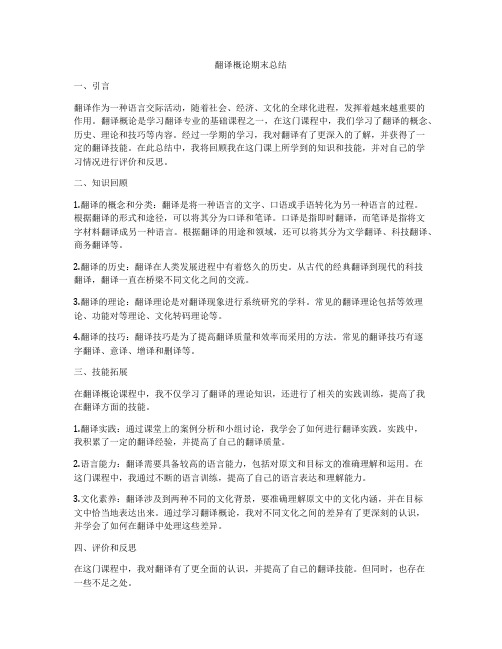
翻译概论期末总结一、引言翻译作为一种语言交际活动,随着社会、经济、文化的全球化进程,发挥着越来越重要的作用。
翻译概论是学习翻译专业的基础课程之一,在这门课程中,我们学习了翻译的概念、历史、理论和技巧等内容。
经过一学期的学习,我对翻译有了更深入的了解,并获得了一定的翻译技能。
在此总结中,我将回顾我在这门课上所学到的知识和技能,并对自己的学习情况进行评价和反思。
二、知识回顾1.翻译的概念和分类:翻译是将一种语言的文字、口语或手语转化为另一种语言的过程。
根据翻译的形式和途径,可以将其分为口译和笔译。
口译是指即时翻译,而笔译是指将文字材料翻译成另一种语言。
根据翻译的用途和领域,还可以将其分为文学翻译、科技翻译、商务翻译等。
2.翻译的历史:翻译在人类发展进程中有着悠久的历史。
从古代的经典翻译到现代的科技翻译,翻译一直在桥梁不同文化之间的交流。
3.翻译的理论:翻译理论是对翻译现象进行系统研究的学科。
常见的翻译理论包括等效理论、功能对等理论、文化转码理论等。
4.翻译的技巧:翻译技巧是为了提高翻译质量和效率而采用的方法。
常见的翻译技巧有逐字翻译、意译、增译和删译等。
三、技能拓展在翻译概论课程中,我不仅学习了翻译的理论知识,还进行了相关的实践训练,提高了我在翻译方面的技能。
1.翻译实践:通过课堂上的案例分析和小组讨论,我学会了如何进行翻译实践。
实践中,我积累了一定的翻译经验,并提高了自己的翻译质量。
2.语言能力:翻译需要具备较高的语言能力,包括对原文和目标文的准确理解和运用。
在这门课程中,我通过不断的语言训练,提高了自己的语言表达和理解能力。
3.文化素养:翻译涉及到两种不同的文化背景,要准确理解原文中的文化内涵,并在目标文中恰当地表达出来。
通过学习翻译概论,我对不同文化之间的差异有了更深刻的认识,并学会了如何在翻译中处理这些差异。
四、评价和反思在这门课程中,我对翻译有了更全面的认识,并提高了自己的翻译技能。
但同时,也存在一些不足之处。
外国翻译理论期末总结
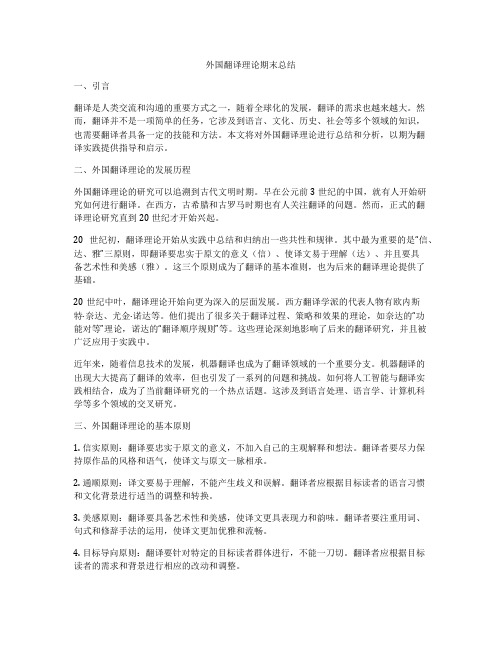
外国翻译理论期末总结一、引言翻译是人类交流和沟通的重要方式之一,随着全球化的发展,翻译的需求也越来越大。
然而,翻译并不是一项简单的任务,它涉及到语言、文化、历史、社会等多个领域的知识,也需要翻译者具备一定的技能和方法。
本文将对外国翻译理论进行总结和分析,以期为翻译实践提供指导和启示。
二、外国翻译理论的发展历程外国翻译理论的研究可以追溯到古代文明时期。
早在公元前3世纪的中国,就有人开始研究如何进行翻译。
在西方,古希腊和古罗马时期也有人关注翻译的问题。
然而,正式的翻译理论研究直到20世纪才开始兴起。
20世纪初,翻译理论开始从实践中总结和归纳出一些共性和规律。
其中最为重要的是“信、达、雅”三原则,即翻译要忠实于原文的意义(信)、使译文易于理解(达)、并且要具备艺术性和美感(雅)。
这三个原则成为了翻译的基本准则,也为后来的翻译理论提供了基础。
20世纪中叶,翻译理论开始向更为深入的层面发展。
西方翻译学派的代表人物有欧内斯特·奈达、尤金·诺达等。
他们提出了很多关于翻译过程、策略和效果的理论,如奈达的“功能对等”理论,诺达的“翻译顺序规则”等。
这些理论深刻地影响了后来的翻译研究,并且被广泛应用于实践中。
近年来,随着信息技术的发展,机器翻译也成为了翻译领域的一个重要分支。
机器翻译的出现大大提高了翻译的效率,但也引发了一系列的问题和挑战。
如何将人工智能与翻译实践相结合,成为了当前翻译研究的一个热点话题。
这涉及到语言处理、语言学、计算机科学等多个领域的交叉研究。
三、外国翻译理论的基本原则1. 信实原则:翻译要忠实于原文的意义,不加入自己的主观解释和想法。
翻译者要尽力保持原作品的风格和语气,使译文与原文一脉相承。
2. 通顺原则:译文要易于理解,不能产生歧义和误解。
翻译者应根据目标读者的语言习惯和文化背景进行适当的调整和转换。
3. 美感原则:翻译要具备艺术性和美感,使译文更具表现力和韵味。
翻译者要注重用词、句式和修辞手法的运用,使译文更加优雅和流畅。
翻译课理论知识点总结
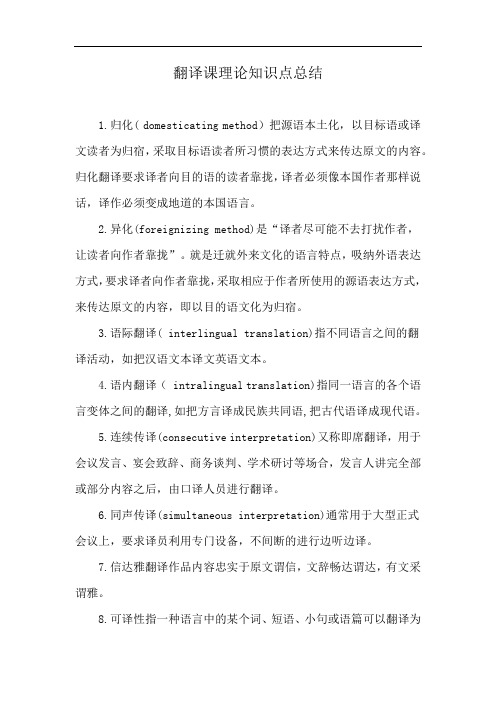
翻译课理论知识点总结1.归化( domesticating method)把源语本土化,以目标语或译文读者为归宿,采取目标语读者所习惯的表达方式来传达原文的内容。
归化翻译要求译者向目的语的读者靠拢,译者必须像本国作者那样说话,译作必须变成地道的本国语言。
2.异化(foreignizing method)是“译者尽可能不去打扰作者,让读者向作者靠拢”。
就是迁就外来文化的语言特点,吸纳外语表达方式,要求译者向作者靠拢,采取相应于作者所使用的源语表达方式,来传达原文的内容,即以目的语文化为归宿。
3.语际翻译( interlingual translation)指不同语言之间的翻译活动,如把汉语文本译文英语文本。
4.语内翻译( intralingual translation)指同一语言的各个语言变体之间的翻译,如把方言译成民族共同语,把古代语译成现代语。
5.连续传译(consecutive interpretation)又称即席翻译,用于会议发言、宴会致辞、商务谈判、学术研讨等场合,发言人讲完全部或部分内容之后,由口译人员进行翻译。
6.同声传译(simultaneous interpretation)通常用于大型正式会议上,要求译员利用专门设备,不间断的进行边听边译。
7.信达雅翻译作品内容忠实于原文谓信,文辞畅达谓达,有文采谓雅。
8.可译性指一种语言中的某个词、短语、小句或语篇可以翻译为另一种语言的可能性程度。
9.形合(hypotaxis)指句中的词语或分句之间需要一种语言形式手段(如连词或关联词)连接起来,表达一定的语法意义和逻辑关系。
10.意合(parataxis)之词语或分句之间不用语言形式手段进行连接,句中的语法意义和逻辑关系通过词语或分句的含义来表达。
11直译(literal translation)即直接翻译,指译文基本上按原文的形式和结构进行翻译,但也并非是死扣原文,字字翻译12意译( free translation)不拘泥于原文的语言形式和结构,按译文的习惯将原文意义表达出来。
翻译理论与实践基础知识回顾课件

翻译理论的主要流派
总结词
翻译理论的主要流派包括语言学派、文学学派、文化 学派和社会学派。
详细描述
语言学派强调语言结构和功能的分析,关注语言之间 的对等和转换。文学学派关注文学作品的翻译,强调 译文的文学性和艺术性。文化学派则关注文化背景和 内涵的传递,强调文化之间的交流和理解。社会学派 则将翻译置于社会语境中考虑,关注翻译的社会功能 和影响。这些流派各有侧重,但都是为了提高翻译的 质量和效果,帮助读者更好地理解和欣赏原作。
01
02
03
增词
在译文中增加一些原文中 没有的词句,以使译文更 加流畅、自然,补充原文 中隐含的译文更加简洁、 明了,避免冗余和重复。
词类转译
改变原文中某些词的词性 ,以适应目标语的表达习 惯和语法规则,使译文更 加地道、自然。
03
语言与文化差异
语言结构差异
翻译理论与实践基础 知识回顾课件
目录
CONTENTS
• 翻译理论概述 • 翻译技巧与实践 • 语言与文化差异 • 翻译中的常见问题与对策 • 翻译工具与技术 • 翻译实践案例分析
01
翻译理论概述
翻译的定义与性质
总结词:翻译是一种跨语言、跨文化的交际活动,是 将一种语言的信息用另一种语言表达出来,以实现信 息的传递和交流。翻译的性质包括语言性、文化性和 交际性。
总结词
文化意象是指在不同文化背景下形成的特定形象或概念,对于翻译者来说,如何 处理这些文化意象是翻译过程中的一大挑战。
详细描述
在翻译过程中,对于一些具有特定文化背景的词汇或表达方式,需要进行适当的 解释或转换,以避免因文化差异造成的误解。例如,“龙”在中西方文化中的含 义截然不同,翻译时需要特别注意。
翻译理论知识点总结

翻译理论知识点总结翻译是指将一种语言的文字转换成另一种语言的过程。
在这个过程中,翻译者需要考虑很多因素,比如语言的语法结构、词汇选择、语言习惯等。
翻译理论是研究翻译过程的学科,它探讨了翻译的原理和方法,为翻译工作者提供了理论指导。
本文将对翻译理论的一些重要知识点进行总结,希望能对翻译工作者有所帮助。
一、翻译的定义翻译的定义是翻译理论研究的出发点。
翻译是指将一种语言的文字转换成另一种语言的过程,目的是使得目标语言读者能够理解源语言的信息。
翻译的对象可以是各种类型的文本,比如文学作品、科技论文、商业合同等。
翻译的过程包括解读源语言文字的意思、选择合适的词汇和语法结构、组织语言篇章等。
二、翻译的类型翻译的类型根据不同的标准可以进行分类。
按照翻译的形式可以分为口译和笔译;按照翻译的用途可以分为文学翻译、科技翻译、商务翻译等;按照翻译的对象语言可以分为中译英、英译中、中译法、法译中等。
不同类型的翻译有不同的特点和要求,翻译者需要根据具体的情况选择合适的翻译方法和策略。
三、翻译的原则翻译的原则是指在翻译过程中需要遵循的准则和规范。
翻译的原则包括忠实原则、通顺原则、信达原则等。
忠实原则要求翻译者要忠实于源语言的表达,不得随意增加、删减或变换原文的意思;通顺原则要求翻译的语言要通顺自然,不得出现生硬、拗口的表达;信达原则要求翻译的目的是让目标语言读者能够理解源语言的信息,不得出现歧义或误导。
四、翻译的方法翻译的方法是指翻译者在具体的翻译实践中采取的手段和策略。
常见的翻译方法包括直译、意译、游移译等。
直译是指尽可能地保持源语言文字的形式和结构,对词句进行逐字逐句翻译;意译是指根据目标语言的语言习惯和表达习惯,对源语言的意思进行调整和转换;游移译是指在直译和意译之间进行灵活地跳跃,根据具体的翻译情况选择合适的翻译方式。
五、翻译的难点翻译的难点是指在翻译过程中可能遇到的困难和问题。
常见的翻译难点包括语言障碍、文化差异、语域差异等。
翻译理论知识回顾

翻译理论知识回顾Basic Knowledge of Translation TheoryI.Translation1.Definition1)The Definition in the Old Days●“译即易,谓换易言语使相解也。
”——贾公彦(618-907) 唐朝●“夫翻译者,谓翻梵天之语转成汉地之言。
音虽似别,义则大同。
”——法云(960-1279)宋代It means that translation is a rendering from one language (Source Language) into another (Target Language), remaining the meaning.●The British scholar Dr. Samuel Johnson once said: “To translate is to changeinto another language, remaining the sense.”2)The Current Definition●The American translation theorist Eugene A. Nida wrote in 1964: Translationconsists in reproducing in the receptor language the closest natural equivalence of the source language, first in terms of meaning and secondly in terms of style.(所谓翻译,是在译语中用切近而又最自然的对等语再现原语的信息,首先是意义,其次是文体。
)1)再现原文的信息(message)而不是保留原文的形式结构(formal structure)2)对等(equivalence)不是同一(identity)3)对等是最贴近、自然的对等4)意义是优先考虑的因素5)文体很重要●The British translation theorist Tytler’s definition in 1970 abouttranslation: “A good translation is one which the merit of the original work is so completely transfused into another language as to be as distinctly apprehended and as strongly felt by a native of the country to which that language belongs as it is by those who speak the language of the ori ginal work.”●Prof. Huang Long TranslatologyTranslation may be defined as follows:The replacement of textual material in one language (SL) by equivalent textual material in another language (TL)(翻译可以作以下界定:用一种语言(目的语)的文本材料对等地再现另一种语言(源出语)的文本材料。
夜班翻译必备知识点总结

夜班翻译必备知识点总结一、翻译理论知识1. 目的论翻译理论目的论翻译理论认为翻译的目的是为了传递信息,强调在翻译过程中应该尽可能准确地传达原文的信息。
翻译者需要根据目的语言和受众的特点来选择合适的翻译策略,以达到最佳的传达效果。
2. 等值理论翻译理论等值理论翻译理论认为翻译应该追求原文与译文之间的等值性,即在意义、信息、风格等方面与原文保持一致。
翻译者需要在保持原文意思的基础上,尽量使译文符合目的语言的语言特点和习惯。
3. 功能对等翻译理论功能对等翻译理论认为翻译应该根据译文所要完成的功能来选择翻译策略。
翻译者需要在传达原文意思的同时,考虑到译文在目的语境中的实际功能,并灵活运用各种翻译技巧来实现最佳的传达效果。
二、语言知识1. 语言能力夜班翻译者需要具有良好的听、说、读、写等语言能力,能够准确理解原文,并流利地表达译文。
同时,还需要具有较强的语言感知能力,能够捕捉原文的语言风格、情感色彩等特点,然后灵活运用目的语言来表达。
2. 语言组织能力夜班翻译者需要具有良好的语言组织能力,能够准确地理解原文的句子结构、语法规则等,然后合理地组织目的语言的表达方式,使译文更加准确、流畅。
3. 词汇积累夜班翻译者需要具有丰富的词汇积累,尤其是专业领域的词汇。
译文中如果使用了大量的生僻词汇,就需要译文的读者对这些词汇有所了解,否则会影响译文的理解和接受。
4. 文化背景夜班翻译者需要对原文所涉及的文化背景有一定的了解,尤其是涉及到习俗、风土人情等方面的内容。
只有了解原文背后的文化内涵,才能准确地传达原文的意义。
三、专业知识1. 行业专业知识夜班翻译者需要对自己所翻译的内容有一定的了解,尤其是涉及到行业专业知识的内容。
只有对行业有一定的了解,才能更好地理解原文并准确地表达译文,从而满足受众的需求。
2. 熟悉常见术语夜班翻译者需要熟悉常见的领域术语,尤其是涉及到专业领域的翻译。
只有对专业术语有一定的了解,才能准确地理解原文,并用目的语言合理地表达。
中西翻译理论整理汇总
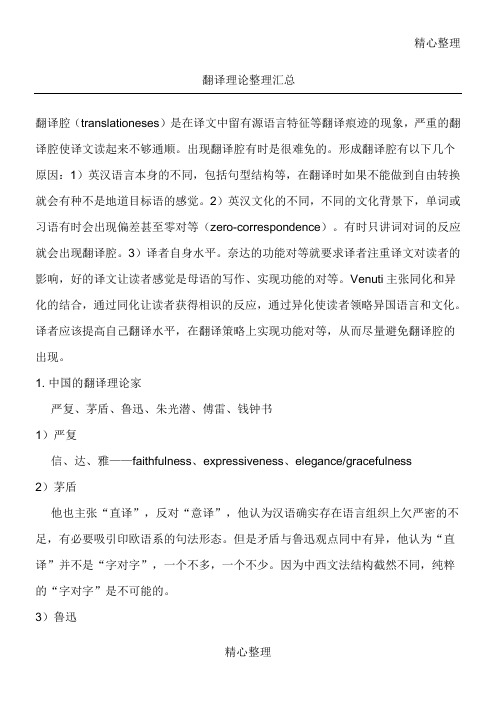
精心整理翻译理论整理汇总翻译腔(translationeses)是在译文中留有源语言特征等翻译痕迹的现象,严重的翻译腔使译文读起来不够通顺。
出现翻译腔有时是很难免的。
形成翻译腔有以下几个原因:1)英汉语言本身的不同,包括句型结构等,在翻译时如果不能做到自由转换就会有种不是地道目标语的感觉。
2)英汉文化的不同,不同的文化背景下,单词或习语有时会出现偏差甚至零对等(zero-correspondence)。
有时只讲词对词的反应就会出现翻译腔。
3)译者自身水平。
奈达的功能对等就要求译者注重译文对读者的影响,好的译文让读者感觉是母语的写作、实现功能的对等。
Venuti主张同化和异化的结合,通过同化让读者获得相识的反应,通过异化使读者领略异国语言和文化。
译者应该提高自己翻译水平,在翻译策略上实现功能对等,从而尽量避免翻译腔的出现。
1. 中国的翻译理论家严复、茅盾、鲁迅、朱光潜、傅雷、钱钟书1)严复信、达、雅——faithfulness、expressiveness、elegance/gracefulness2)茅盾他也主张“直译”,反对“意译”,他认为汉语确实存在语言组织上欠严密的不足,有必要吸引印欧语系的句法形态。
但是矛盾与鲁迅观点同中有异,他认为“直译”并不是“字对字”,一个不多,一个不少。
因为中西文法结构截然不同,纯粹的“字对字”是不可能的。
3)鲁迅鲁迅的“宁信而不顺”是“凡是翻译,必须兼顾两面,一当然是力求易解,一则保存着原作风姿”,这是鲁迅的基本思想。
针对当年那种“牛头不对马嘴”的胡译、乱译以及所谓“与其信而不顺,不如顺而不信”的说法(梁秋实),提出了“宁信而不顺”这一原则,主张直译,以照顾输入新表现法和保持原作的风貌。
他还认为,翻译一要“移情”、“益志”,译文要有“异国情调”,二要“输入新的表现法”,以改进中文的文法,在当时主要表现为改进白话文。
必须强调的是,鲁迅其实是主张翻译要通顺,又要忠实的。
翻译理论全面总结
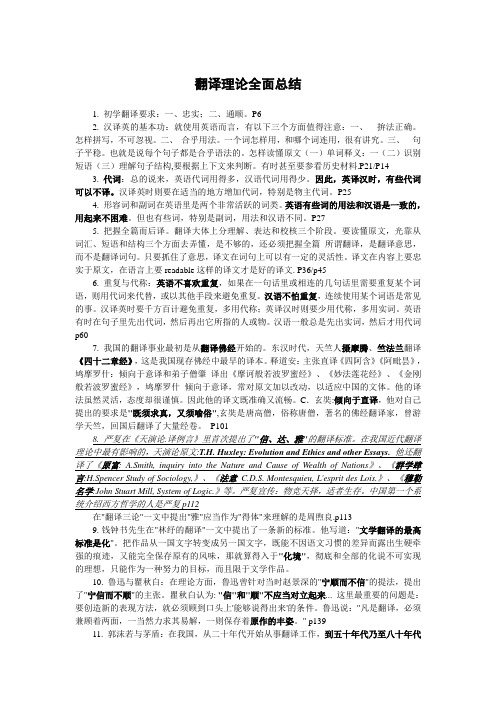
翻译理论全面总结1. 初学翻译要求:一、忠实;二、通顺。
P62. 汉译英的基本功:就使用英语而言,有以下三个方面值得注意:一、拚法正确。
怎样拼写,不可忽视。
二、合乎用法。
一个词怎样用,和哪个词连用,很有讲究。
三、句子平稳。
也就是说每个句子都是合乎语法的。
怎样读懂原文(一)单词释义:一(二)识别短语(三)理解句子结构,要根据上下文来判断。
有时甚至要参看历史材料.P21/P143. 代词:总的说来,英语代词用得多,汉语代词用得少。
因此,英译汉时,有些代词可以不译。
汉译英时则要在适当的地方增加代词,特别是物主代词。
P254. 形容词和副词在英语里是两个非常活跃的词类。
英语有些词的用法和汉语是一致的,用起来不困难。
但也有些词,特别是副词,用法和汉语不同。
P275. 把握全篇而后译。
翻译大体上分理解、表达和校核三个阶段。
要读懂原文,光靠从词汇、短语和结构三个方面去弄懂,是不够的,还必须把握全篇所谓翻译,是翻译意思,而不是翻译词句。
只要抓住了意思,译文在词句上可以有一定的灵活性。
译文在内容上要忠实于原文,在语言上要readable这样的译文才是好的译文. P36/p456. 重复与代称:英语不喜欢重复,如果在一句话里或相连的几句话里需要重复某个词语,则用代词来代替,或以其他手段来避免重复。
汉语不怕重复,连续使用某个词语是常见的事。
汉译英时要千方百计避免重复,多用代称;英译汉时则要少用代称,多用实词。
英语有时在句子里先出代词,然后再出它所指的人或物。
汉语一般总是先出实词,然后才用代词p607. 我国的翻译事业最初是从翻译佛经开始的。
东汉时代,天竺人摄摩腾、竺法兰翻译《四十二章经》,这是我国现存佛经中最早的译本。
释道安:主张直译《四阿含》《阿毗昙》,鸠摩罗什:倾向于意译和弟子僧肇译出《摩诃般若波罗蜜经》、《妙法莲花经》、《金刚般若波罗蜜经》,鸠摩罗什倾向于意译,常对原文加以改动,以适应中国的文体。
他的译法虽然灵活,态度却很谨慎。
翻译理论总结期末
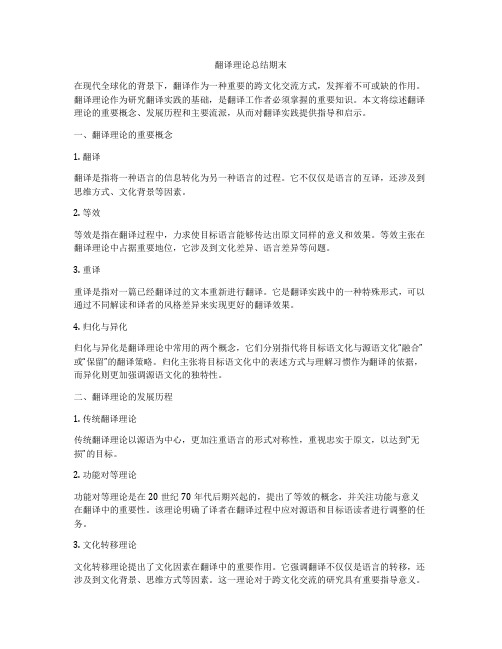
翻译理论总结期末在现代全球化的背景下,翻译作为一种重要的跨文化交流方式,发挥着不可或缺的作用。
翻译理论作为研究翻译实践的基础,是翻译工作者必须掌握的重要知识。
本文将综述翻译理论的重要概念、发展历程和主要流派,从而对翻译实践提供指导和启示。
一、翻译理论的重要概念1. 翻译翻译是指将一种语言的信息转化为另一种语言的过程。
它不仅仅是语言的互译,还涉及到思维方式、文化背景等因素。
2. 等效等效是指在翻译过程中,力求使目标语言能够传达出原文同样的意义和效果。
等效主张在翻译理论中占据重要地位,它涉及到文化差异、语言差异等问题。
3. 重译重译是指对一篇已经翻译过的文本重新进行翻译。
它是翻译实践中的一种特殊形式,可以通过不同解读和译者的风格差异来实现更好的翻译效果。
4. 归化与异化归化与异化是翻译理论中常用的两个概念,它们分别指代将目标语文化与源语文化“融合”或“保留”的翻译策略。
归化主张将目标语文化中的表述方式与理解习惯作为翻译的依据,而异化则更加强调源语文化的独特性。
二、翻译理论的发展历程1. 传统翻译理论传统翻译理论以源语为中心,更加注重语言的形式对称性,重视忠实于原文,以达到“无损”的目标。
2. 功能对等理论功能对等理论是在20世纪70年代后期兴起的,提出了等效的概念,并关注功能与意义在翻译中的重要性。
该理论明确了译者在翻译过程中应对源语和目标语读者进行调整的任务。
3. 文化转移理论文化转移理论提出了文化因素在翻译中的重要作用。
它强调翻译不仅仅是语言的转移,还涉及到文化背景、思维方式等因素。
这一理论对于跨文化交流的研究具有重要指导意义。
4. 重译和再翻译理论重译和再翻译理论强调翻译是一个不断发展的过程,通过对已有翻译作品的再审视和重新翻译,可以实现更好的翻译效果。
这一理论提醒翻译者不仅要注重翻译策略,还要不断提升自己的翻译水平。
三、翻译理论的主要流派1. 源语导向理论源语导向理论以源语为中心,强调翻译要忠实于原文,力求实现“无损”翻译。
1 翻译理论与实践-基础知识回顾

漂亮的猎装、猎枪、刀子和刀鞘,全套最新奇的各色背心以及 当时十分时髦的各式硬领与领带,并把母亲给他的一套华丽纯 金梳妆用具也随身带着。查理以为在伯父家能遇到上百的客人, 一心想到他森林中去围猎,过一下宫堡生活。但这里的一切都 使他感到失望,客人都是些衣冠不整、邋遢衰老的人,房子破
旧,陈设简陋,仆人俗气,生活平淡。
HomeIndexBackforth
杨必翻译作品初览
Vanity Fair
名利场
Although schoolmistresses'
letters are to be trusted no more
一般说来,校长(女教师)的
nor less than churchyard epitaphs; 信和墓志铭一样靠不住。不过
4 《汉译英教程》,司显柱 曾剑平等编著,东华大学 出版社,2006
5 《汉译英基础教程》,马秉义编著,中国对外翻译 出版公司,2006
6 《汉译英理论与实践教程》,程永生编著,外语教 学与研究出版社,2005
7 《西方翻译简史》,谭载喜著,商务印书馆,2000
Basics of Translation (II)
传部《毛泽东选集》英文编译委员会委员,中共中央对外联络部
毛选英文编译定稿小组成员。长期致力于中国和西方文学的研究。
主张用比较文学、心理学、单位观念史学、风格学、哲理意义学
等多学科的方法,从多种角度理解和评价文学作品。著有散文集
《写在人生边上》,短篇小说集《人•兽•鬼》,长篇小说《围
城》,选本《宋诗选注》。文论集《七缀集》、《谈艺录》及
Home
Index
大学翻译课知识点总结
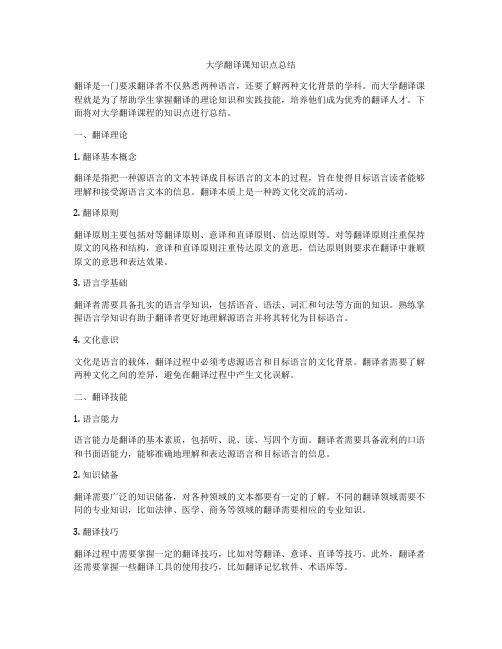
大学翻译课知识点总结翻译是一门要求翻译者不仅熟悉两种语言,还要了解两种文化背景的学科。
而大学翻译课程就是为了帮助学生掌握翻译的理论知识和实践技能,培养他们成为优秀的翻译人才。
下面将对大学翻译课程的知识点进行总结。
一、翻译理论1. 翻译基本概念翻译是指把一种源语言的文本转译成目标语言的文本的过程,旨在使得目标语言读者能够理解和接受源语言文本的信息。
翻译本质上是一种跨文化交流的活动。
2. 翻译原则翻译原则主要包括对等翻译原则、意译和直译原则、信达原则等。
对等翻译原则注重保持原文的风格和结构,意译和直译原则注重传达原文的意思,信达原则则要求在翻译中兼顾原文的意思和表达效果。
3. 语言学基础翻译者需要具备扎实的语言学知识,包括语音、语法、词汇和句法等方面的知识。
熟练掌握语言学知识有助于翻译者更好地理解源语言并将其转化为目标语言。
4. 文化意识文化是语言的载体,翻译过程中必须考虑源语言和目标语言的文化背景。
翻译者需要了解两种文化之间的差异,避免在翻译过程中产生文化误解。
二、翻译技能1. 语言能力语言能力是翻译的基本素质,包括听、说、读、写四个方面。
翻译者需要具备流利的口语和书面语能力,能够准确地理解和表达源语言和目标语言的信息。
2. 知识储备翻译需要广泛的知识储备,对各种领域的文本都要有一定的了解。
不同的翻译领域需要不同的专业知识,比如法律、医学、商务等领域的翻译需要相应的专业知识。
3. 翻译技巧翻译过程中需要掌握一定的翻译技巧,比如对等翻译、意译、直译等技巧。
此外,翻译者还需要掌握一些翻译工具的使用技巧,比如翻译记忆软件、术语库等。
4. 翻译实践翻译实践是提高翻译水平的重要手段,通过大量翻译练习可以提高翻译速度和准确度,培养翻译者的审美能力和创造力。
三、翻译方法1. 直译直译是指尽量保持源语言的结构和风格,只在必要的情况下做出一些改动。
直译的特点是忠实于原文,同时在保持原文意思的基础上作出必要的修饰。
2. 意译意译是指在翻译过程中放弃源语言的词句,而用目标语言的词句表达相同的意义。
翻译基本理论知识点
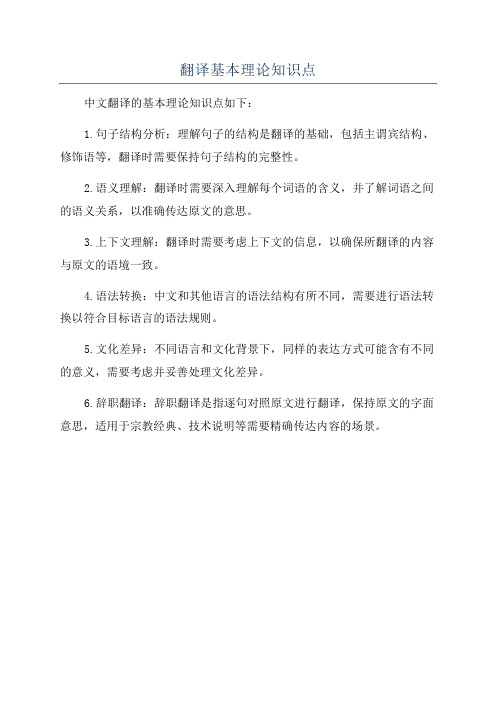
翻译基本理论知识点
中文翻译的基本理论知识点如下:
1.句子结构分析:理解句子的结构是翻译的基础,包括主谓宾结构、修饰语等,翻译时需要保持句子结构的完整性。
2.语义理解:翻译时需要深入理解每个词语的含义,并了解词语之间的语义关系,以准确传达原文的意思。
3.上下文理解:翻译时需要考虑上下文的信息,以确保所翻译的内容与原文的语境一致。
4.语法转换:中文和其他语言的语法结构有所不同,需要进行语法转换以符合目标语言的语法规则。
5.文化差异:不同语言和文化背景下,同样的表达方式可能含有不同的意义,需要考虑并妥善处理文化差异。
6.辞职翻译:辞职翻译是指逐句对照原文进行翻译,保持原文的字面意思,适用于宗教经典、技术说明等需要精确传达内容的场景。
翻译理论知识
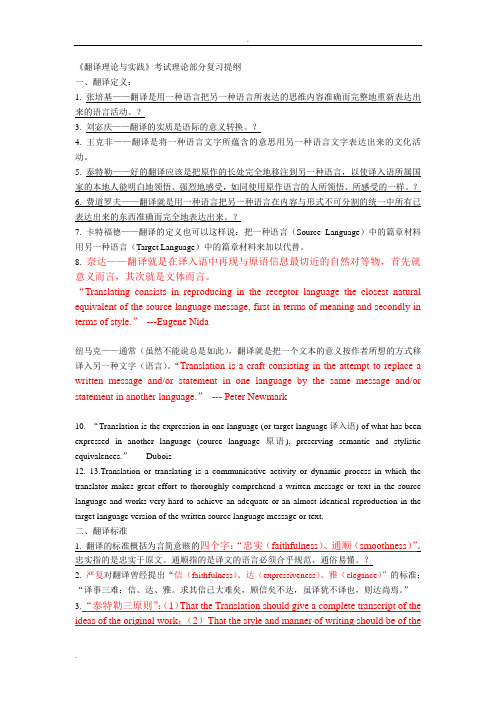
《翻译理论与实践》考试理论部分复习提纲一、翻译定义:1. 张培基——翻译是用一种语言把另一种语言所表达的思维内容准确而完整地重新表达出来的语言活动。
?3. 刘宓庆——翻译的实质是语际的意义转换。
?4. 王克非——翻译是将一种语言文字所蕴含的意思用另一种语言文字表达出来的文化活动。
5. 泰特勒——好的翻译应该是把原作的长处完全地移注到另一种语言,以使译入语所属国家的本地人能明白地领悟、强烈地感受,如同使用原作语言的人所领悟、所感受的一样。
?6. 费道罗夫——翻译就是用一种语言把另一种语言在内容与形式不可分割的统一中所有已表达出来的东西准确而完全地表达出来。
?7. 卡特福德——翻译的定义也可以这样说:把一种语言(Source Language)中的篇章材料用另一种语言(Target Language)中的篇章材料来加以代替。
8.奈达——翻译就是在译入语中再现与原语信息最切近的自然对等物,首先就意义而言,其次就是文体而言。
“Translating consists in reproducing in the receptor language the closest natural equivalent of the source language message, first in terms of meaning and secondly in terms of style.”---Eugene Nida纽马克——通常(虽然不能说总是如此),翻译就是把一个文本的意义按作者所想的方式移译入另一种文字(语言)。
“Translation is a craft consisting in the attempt to replace a written message and/or statement in one language by the same message and/or statement in another language.”--- Peter Newmark10. “Translation is the expression in one language (or target language译入语) of what has been expressed in another language (source language 原语), preserving semantic and stylistic equivalences.”--- Dubois12. 13.Translation or translating is a communicative activity or dynamic process in which the translator makes great effort to thoroughly comprehend a written message or text in the source language and works very hard to achieve an adequate or an almost identical reproduction in the target language version of the written source language message or text.二、翻译标准1. 翻译的标准概括为言简意赅的四个字:“忠实(faithfulness)、通顺(smoothness)”。
翻译常识知识点总结
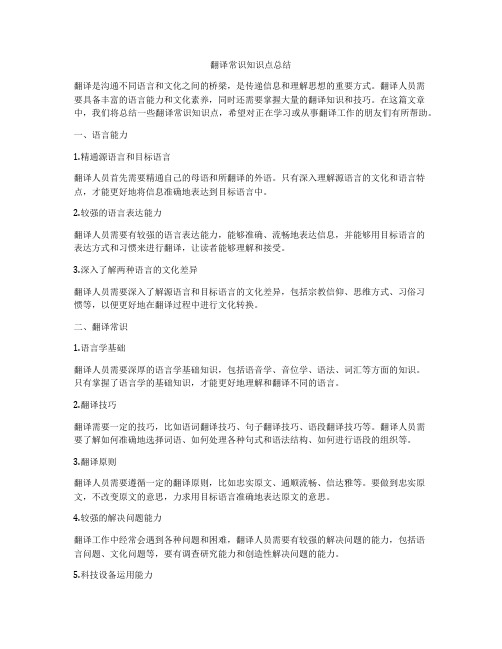
翻译常识知识点总结翻译是沟通不同语言和文化之间的桥梁,是传递信息和理解思想的重要方式。
翻译人员需要具备丰富的语言能力和文化素养,同时还需要掌握大量的翻译知识和技巧。
在这篇文章中,我们将总结一些翻译常识知识点,希望对正在学习或从事翻译工作的朋友们有所帮助。
一、语言能力1.精通源语言和目标语言翻译人员首先需要精通自己的母语和所翻译的外语。
只有深入理解源语言的文化和语言特点,才能更好地将信息准确地表达到目标语言中。
2.较强的语言表达能力翻译人员需要有较强的语言表达能力,能够准确、流畅地表达信息,并能够用目标语言的表达方式和习惯来进行翻译,让读者能够理解和接受。
3.深入了解两种语言的文化差异翻译人员需要深入了解源语言和目标语言的文化差异,包括宗教信仰、思维方式、习俗习惯等,以便更好地在翻译过程中进行文化转换。
二、翻译常识1.语言学基础翻译人员需要深厚的语言学基础知识,包括语音学、音位学、语法、词汇等方面的知识。
只有掌握了语言学的基础知识,才能更好地理解和翻译不同的语言。
2.翻译技巧翻译需要一定的技巧,比如语词翻译技巧、句子翻译技巧、语段翻译技巧等。
翻译人员需要了解如何准确地选择词语、如何处理各种句式和语法结构、如何进行语段的组织等。
3.翻译原则翻译人员需要遵循一定的翻译原则,比如忠实原文、通顺流畅、信达雅等。
要做到忠实原文,不改变原文的意思,力求用目标语言准确地表达原文的意思。
4.较强的解决问题能力翻译工作中经常会遇到各种问题和困难,翻译人员需要有较强的解决问题的能力,包括语言问题、文化问题等,要有调查研究能力和创造性解决问题的能力。
5.科技设备运用能力随着科技的不断发展,翻译人员需要掌握一些科技设备的运用,比如语音识别软件、翻译工具等,可以提高翻译效率和质量。
6.翻译伦理翻译人员需要具备正确的翻译伦理,比如尊重原文作者的原意、不随意篡改原文内容等,要有道德修养和职业操守。
三、译者修养1.永远在路上翻译人员需要不断学习和提高自己的翻译能力,要不断地钻研语言学、翻译学等相关知识,不断地丰富自己的词汇量和知识储备。
翻译理论总结

(1)杨宪益•贯穿其毕生翻译事业的文化理念——忠实传达中国文化的价值与灵魂,忠实传达中国人的人生,也将更见其卓越的光彩。
•杨宪益强调“翻译时不能做过多的解释。
译者应尽量重视原文”,否则“就不是翻译,而是改写了”。
他重视原文,比较强调“信”。
他曾说,“古人说了三个字:信、达、雅。
当然,光‘信’不‘达’也是不可能,那是不要人懂。
所谓‘信’,就是不能(和原文)走得太远。
如外国人觉得rose(玫瑰)很了不起,(能够代表爱情等美好的事物)而中国人觉得牡丹是最好的,把玫瑰翻译成牡丹,这就只做到了‘达’,忽略了信。
”•杨宪益夫妇的翻译作品有一个广为人知的特点,就是从内容到精神都高度忠实于原著,体现出一种不虚美、不隐善的文化立场。
(2)秋老虎the strongest hot days in the summerThe Voice of China 中国好声音•稳定压倒一切Maintaining stability is of top priority.•发展是硬道理Development is of overriding importance.Development is the absolute need.•开后门under-the-counter deals; offer advantages to one's friends or relatives by underhand means•充电recharge one’s batteries; update one's knowledge•形象工程vanity projects•按劳分配distribution according to one's performance•餐饮业catering industry•出境游outbound tourism•放心肉quality-assured meat•蓝牙技术bluetooth•生源地助学贷款locally-granted student loan•户籍所在地registered permanent residence•相亲blind date•综艺节目variety show•恶搞spoof•收视率viewing rate•旅游热tourism wave (mania; fever)•学历造假fabricate academic credentials嘴甜honey-lipped(3) 林纾❖归化,意译( domesticating translation;free translation)是林纾采用的基本翻译策略。
- 1、下载文档前请自行甄别文档内容的完整性,平台不提供额外的编辑、内容补充、找答案等附加服务。
- 2、"仅部分预览"的文档,不可在线预览部分如存在完整性等问题,可反馈申请退款(可完整预览的文档不适用该条件!)。
- 3、如文档侵犯您的权益,请联系客服反馈,我们会尽快为您处理(人工客服工作时间:9:00-18:30)。
翻译理论知识回顾Basic Knowledge of Translation TheoryI.Translation1.Definition1)The Definition in the Old Days●“译即易,谓换易言语使相解也。
”——贾公彦(618-907) 唐朝●“夫翻译者,谓翻梵天之语转成汉地之言。
音虽似别,义则大同。
”——法云(960-1279)宋代It means that translation is a rendering from one language (Source Language) into another (Target Language), remaining the meaning.●The British scholar Dr. Samuel Johnson once said: “To translate is to changeinto another language, remaining the sense.”2)The Current Definition●The American translation theorist Eugene A. Nida wrote in 1964: Translationconsists in reproducing in the receptor language the closest natural equivalence of the source language, first in terms of meaning and secondly in terms of style.(所谓翻译,是在译语中用切近而又最自然的对等语再现原语的信息,首先是意义,其次是文体。
)1)再现原文的信息(message)而不是保留原文的形式结构(formal structure)2)对等(equivalence)不是同一(identity)3)对等是最贴近、自然的对等4)意义是优先考虑的因素5)文体很重要●The British translation theorist Tytler’s definition in 1970 abouttranslation: “A good translation is one which the merit of the original work is so completely transfused into another language as to be as distinctly apprehended and as strongly felt by a native of the country to which that language belongs as it is by those who speak the language of the ori ginal work.”●Prof. Huang Long TranslatologyTranslation may be defined as follows:The replacement of textual material in one language (SL) by equivalent textual material in another language (TL)(翻译可以作以下界定:用一种语言(目的语)的文本材料对等地再现另一种语言(源出语)的文本材料。
)1)部分地替代2)对等概念2.Varieties of Translation1)Interpretation and written translation2)In terms of SL and TL, Interlingual translation语际(不同语言之间),Intralingual translation语内(同一语言rewording),Intersemiotic translation符际(eg.把语言符号用图画、手势、数字或音乐来表达)3)In terms of style, political essay政论,practical writing应用文,scienceand technology科技,literary translation and so on.II.Translation Criteria or Principle●Tytler’s: Essay on the Principles of Translation, 17911) A translation should give a complete transcript of the ideas of theoriginal work.译文应完全复写出原作的思想。
2)The style and manner of writing should be of the same character asthat of the original.译文的风格和笔调应与原文的性质相同。
3) A translation should have all the ease of the original composition.译文应和原作同样流畅。
●Yanfu’s: Faithfulness, Expressiveness and Elegance (信、达、雅)1.“Faithfulness”means the full and complete conveying of theoriginal content of thought.2.“Expressiveness” demands that the version should be clear andflowing without any grammatical mistakes or confused logic andsense.3.“Elegance” refers to the use of classical Chinese before the HanDynasty.In summary, the first two words as translation criteria are acceptable.The original meaning of “Elegance”is unacceptable for today, but we can give it new sense -----elegant style in translation.●Others:Lu Xun’s (鲁迅)translation principle:Rather be faithful (in thought) than smooth (in language) in opposition to Liang Shi-qiu’s translation principle in 1930s. (宁信不顺)Fu Lei’s付雷translation criteria: TL should be similar to SL both in Form and in Spirit. (形似、神似)Liu Chongde’s刘重德translation criteria: faithfulness, expressiveness and closeness. (信、达、切) faithfulness: to be faithful to the content of the original; expressiveness: to be as expressive and smooth as the original; closeness: to be as close to the original style as possible.Liang Shiqiu ‘s and Zhao Jingshen’s (梁实秋,赵景深) translation principle in 1930s: “It’s better to have a smooth version than a faithful one.”宁错务顺Eugene A. Nida’s translation principle: Dynamic equivalence or Functional equivalence or Equivalent-effect theory. The main idea is that the translator is to produce as nearly possible the same effect on his readers as was produced on the readers of the original.Peter Newmark’s translation principle: From the angle of contextual analysis, he puts forward two translation approaches: Semantic translation and Communicative translation.☆ Semantic translation: The translator attempts, within the bare syntactic and semantic constraints of the TL, to produce the precise contextual meaning of the author. Semantic translation focuses primarily upon the semantic content of the source text.☆ Communicative translation: The translator attempts to produce the same effect on the TL readers as was produced by the original on the SL readers. Communicative translation focuses essentially upon the comprehension and response of receptors.III.Translation Strategies: Foreignization and Domestication Foreignization:If the translator’s preference is placed on preserving the language and cultural differences of the Source Text, we call this kind of approaches or its translation foreignizing or foreignization.Domestication:It refers the method or practice of adapting the translation to the norms and values of the Target Language and culture is called domesticating or domestication.IV. Translation MethodsCommon translation methods:1. Transliteration2. Literal Translation3. Free Translation4. Exegetic Translation新闻报刊文体的范畴英美新闻理论一般按新闻报刊材料各体式所具有的“纪实性”(Factualness)即某一类材料包含了多少“事实”(Fact)或者“消息”(Information),而将新闻文体分成三个梯级。
